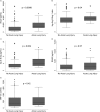Plasma angiopoietin-2 predicts the onset of acute lung injury in critically ill patients
- PMID: 23328529
- PMCID: PMC3678110
- DOI: 10.1164/rccm.201208-1460OC
Plasma angiopoietin-2 predicts the onset of acute lung injury in critically ill patients
Abstract
Rationale: Current clinical prediction scores for acute lung injury (ALI) have limited positive predictive value. No studies have evaluated predictive plasma biomarkers in a broad population of critically ill patients or as an adjunct to clinical prediction scores.
Objectives: To determine whether plasma angiopoietin-2 (Ang-2), von Willebrand factor (vWF), interleukin-8 (IL-8), and/or receptor for advanced glycation end products (sRAGE) predict ALI in critically ill patients.
Methods: Plasma samples were drawn from critically ill patients (n = 230) identified in the emergency department. Patients who had ALI at baseline or in the subsequent 6 hours were excluded, and the remaining patients were followed for development of ALI.
Measurements and main results: Nineteen patients developed ALI at least 6 hours after the sample draw. Higher levels of Ang-2 and IL-8 were significantly associated with increased development of ALI (P = 0.0008, 0.004, respectively). The association between Ang-2 and subsequent development of ALI was robust to adjustment for sepsis and vasopressor use. Ang-2 and the Lung Injury Prediction Score each independently discriminated well between those who developed ALI and those who did not (area under the receiver operating characteristic curve, 0.74 for each), and using the two together improved the area under the curve to 0.84 (vs. 0.74, P = 0.05). In contrast, plasma levels of sRAGE and vWF were not predictive of ALI.
Conclusions: Plasma biomarkers such as Ang-2 can improve clinical prediction scores and identify patients at high risk for ALI. In addition, the early rise of Ang-2 emphasizes the importance of endothelial injury in the early pathogenesis of ALI.
Figures


Comment in
-
Predicting the development of acute respiratory distress syndrome: searching for the “Troponin of ARDS”.Am J Respir Crit Care Med. 2013 Apr 1;187(7):671-2. doi: 10.1164/rccm.201301-0168ed. Am J Respir Crit Care Med. 2013. PMID: 23540873 No abstract available.
References
-
- ARDS Clinical Trials Network Higher versus lower positive end-expiratory pressures in patients with the acute respiratory distress syndrome. N Engl J Med 2004;351:327–336 - PubMed
-
- Meade MO, Cook DJ, Guyatt GH, Slutsky AS, Arabi YM, Cooper DJ, Davies AR, Hand LE, Zhou Q, Thabane L, et al. Lung Open Ventilation Study I. Ventilation strategy using low tidal volumes, recruitment maneuvers, and high positive end-expiratory pressure for acute lung injury and acute respiratory distress syndrome: a randomized controlled trial. JAMA 2008;299:637–645 - PubMed
-
- Mercat A, Richard JC, Vielle B, Jaber S, Osman D, Diehl JL, Lefrant JY, Prat G, Richecoeur J, Nieszkowska A, et al. Expiratory Pressure Study Group. Positive end-expiratory pressure setting in adults with acute lung injury and acute respiratory distress syndrome: a randomized controlled trial. JAMA 2008;299:646–655 - PubMed
-
- Wiedemann HP, Wheeler AP, Bernard GR, Thompson BT, Hayden D, deBoisblanc B, Connors AF, Jr, Hite RD, Harabin AL. National Heart Lung Blood Institute Acute Respiratory Distress Syndrome Clinical Trials Network. Comparison of two fluid-management strategies in acute lung injury. N Engl J Med 2006;354:2564–2575 - PubMed
Publication types
MeSH terms
Substances
Grants and funding
LinkOut - more resources
Full Text Sources
Other Literature Sources
Miscellaneous

